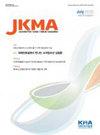膝关节前侧疼痛治疗的最新趋势
IF 0.5
Q3 MEDICINE, GENERAL & INTERNAL
引用次数: 0
摘要
背景:前膝关节疼痛(AKP)综合征是促使活跃的年轻人在运动损伤诊所寻求评估的最常见疾病之一。与一般人群相比,AKP患者发生髌骨关节炎的风险更高。AKP可能对受影响的患者的生活质量有害,在更大的背景下,它可能会显著增加经济负担,带来高昂的医疗费用。本意见旨在对AKP进行综合评价,以提高临床管理水平。当前概念:AKP具有多因素病因。它不仅可以归因于膝盖内部和周围的结构,还可以归因于外部因素,如肢体错位,特定髋关节肌肉群的无力,核心和韧带松弛。因此,AKP需要对患者的病史进行详细的评估,并辅以相关的放射学检查进行彻底的临床检查,以确定其在膝关节的起源和潜在的原因。保守治疗在大多数AKP患者中获得了良好的结果,而只有当膝关节或肢体结构异常与AKP的临床表现相关或保守措施不能提供实质性和持续的症状缓解时,才需要手术治疗。讨论与结论:AKP的治疗策略应根据患者的情况和确定的具体原因进行个体化治疗。因此,AKP的管理需要对患者的病史、临床检查和放射检查进行重点评估,以确定病情的起源和潜在原因。本文章由计算机程序翻译,如有差异,请以英文原文为准。
Recent trends in the management of anterior knee pain
Background: Anterior knee pain (AKP) syndrome is one of the most common conditions that prompt active young individuals to seek evaluation at sports injury clinics. Compared to the general population, patients with AKP appear to be at a higher risk of developing patellofemoral osteoarthritis. AKP can be detrimental to the affected patient’s quality of life and, in the larger context, it could markedly burden the economy with high healthcare costs. This opinion aims to present a comprehensive evaluation of AKP to improve its management in clinical practice.Current Concepts: AKP has a multifactorial etiology. It can be attributed not only to structures within and around the knee but also to external factors, such as limb malalignment, weakness of specific hip muscle groups, and core and ligamentous laxity. Hence, AKP warrants a detailed evaluation of patient’s medical history and a thorough clinical examination complemented by relevant radiological investigations to identify its origin in the knee and the underlying cause. Conservative management yields favorable outcomes in the majority of patients with AKP, whereas surgical management becomes necessary only when well-characterized structural abnormalities of the knee or limb correlate with the clinical presentation of AKP or when conservative measures fail to provide substantial and sustained symptoms relief.Discussion and Conclusion: The treatment strategy for AKP should be individualized based on the patient’s profile and the specific cause identified. Therefore, the management of AKP requires a focused evaluation of the patient’s medical history, clinical examination, and radiological investigations to identify the condition’s origin and underlying cause.
求助全文
通过发布文献求助,成功后即可免费获取论文全文。
去求助
来源期刊

Journal of The Korean Medical Association
Medicine-General Medicine
CiteScore
0.50
自引率
0.00%
发文量
84
审稿时长
4-8 weeks
期刊介绍:
The Journal of the Korean Medical Association (JKMA) is the official peer-reviewed, open-access, monthly journal of the Korean Medical Association (KMA). It contains articles in Korean or English. Its abbreviated title is ''J Korean Med Assoc''. The aims of the Journal include contributing to the treatment of and preventing diseases of public health importance and to improvement of health and quality of life through sharing the state-of the-art scientific information on medicine by the members of KMA and other national and international societies.
 求助内容:
求助内容: 应助结果提醒方式:
应助结果提醒方式:


